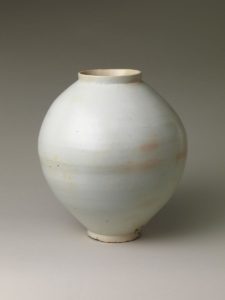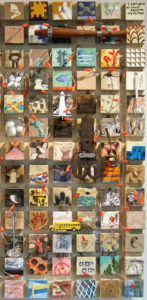
In a glass case against the wall stands the elegant “Moon Jar,” an 18th-century Korean porcelain that is about the size of basketball and nearly as round.
Directly across from it is an installation by the contemporary Korean artist Kang Ik-joong that duplicates the Moon Jar’s form on 25 panels. The tight five-by-five arrangement is reminiscent of those silkscreen multiples of Mao or Marilyn by Andy Warhol, the ones that look like big sheets of stamps.
Kang, however, isn’t affecting the cool detachment of Warhol. For him, “Moon Jar” is an improbably occasion for reveries and dreamy associations.
Of course, like so much postmodern art that relies on borrowed strategies and recycled images, you need to read the wall text to know what’s going on.
Oh, to be as simple and direct as “Moon Jar.”
Kang says moon jars like this one remind him of the floating clouds that he watched as a child from the valley of his Korean home, and the “orange-hued moonrises seen from the plane window as I come into JFK after a long trip,” or the sun slipping into his Manhattan studio while he’s eating Chinese takeout.

Tilework utilizing children’s art
That’s a pretty good capsule description of Kang’s career. Born in 1960, in Cheong Ju, Korea, he came to New York to get an advanced degree from Pratt Institute in 1984 and has been here ever since. Inspired by the tilework in the New York subways, he makes tile-based murals and installations, sometimes soliciting children’s work to make the individual tiles.
On learning that over 50 languages were spoken in the Princeton schools, for example, he had students paint the word “library” in their native language. Some were incorporated into a 30-foot mural, “Happy World,” that used some 5,000 3-inch-square paintings by the artist. “Amazed World 2001,” used 34,000 children’s drawings from all over the globe for a maze-like installation at the United Nations.
In size then, “25 Wishes,” is a modest work for Kang. The panels are just big enough to accommodate a full-sized image of the Moon Jar. Unlike Warhol’s multiples, these are not identical. Some have an asymmetrical bulge on one side, and others have darker shading than their neighbors, as if, like Monet’s haystacks, they were done at different hours of the day. The profile reveals unexpected affinities – the flat shape resembles a Christmas bulb or a Chinese lantern.
The setting for this work, the Art of Korea Gallery, is a modest outpost amid the Met’s often spectacular multi-gallery displays of Chinese and Japanese art, but it provides an elegant capsule history – told mostly through ceramics.
It begins in the late Bronze Age with an iron red jar dated to the fourth century BC. A wonderful bird-shaped vessel from the three Kingdom period (57 BC to 668 A.D.) has a head like a sea horse and a tail that serves as a spout. One big round jar has such tiny decorative handles that even a child couldn’t hook a finger through one.
Dazzling gold earrings from royal tombs dating to this same period are a reminder that Korean gold work was then the most accomplished in all of Asia.
When it came to porcelain, Koreans of the Thirteenth and Fourteenth centuries favored understated pieces, often in celadon, rather than the colorful work that was popular in China and Japan. The elegance and simplicity of these pieces can be seen in a tall light-bulb shaped vase decorated with inlaid cranes and clouds.
A complete trip around the gallery takes you through 2,500 years of art and brings you back to the white “Moon Jar” with its subtle peach blushes and “25 Wishes,” with its self-conscious appropriation and autobiographical reveries.

